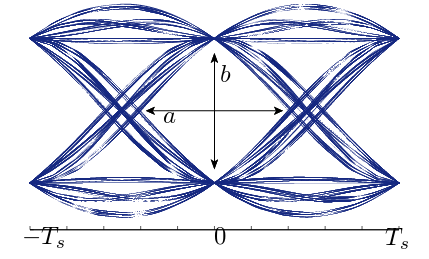Communications Engineering, Signal and Information Transmission
Please note that the documents for the event are primarily made available via Panda. In case of doubt, the Panda documents are more up-to-date than the documents you can retrieve from this website.
Brief description

The Communications Engineering course provides an insight into the broad field of information technology. It deals with coding and the sending, transmitting and receiving of information. Transmission systems are dealt with using the techniques of signal and system theory and statistical signal description. While analogue transmission methods are only briefly discussed, the focus is on digital transmission methods, the elements of which are discussed using the example of pulse amplitude modulation. The lecture concludes with an introduction to information theory, which forms the basis of modern communications engineering. The course is the basis for further courses in the field of information technology.
Lecture contents
- Signals and systems: Continuous-time signals and systems, Fourier transform, correlation functions, discrete-time signals and systems, sampling theorem, low-pass and band-pass, Hilbert transform
- Transmission of analogue signals: amplitude modulation methods, angle modulation methods
- Random variables and random processes: Probability and random experiment, distribution functions and distribution density functions, Gaussian random variables, discrete random variables, expected values, moments and correlations
- Transmission of digital signals: PAM transmission systems, pulse shaping, eye diagrams, matched filters, symbol error rates
- Information theory: entropy, optimal codes, Huffman coding, channel capacity of discrete-time channels
Learning outcomes & professional competences
After completing this course, students will be able to
- describe and analyse communication systems using methods of signal and system theory,
- recognise the advantages of describing signals as stochastic processes and describe and analyse useful and interference signals as random processes,
- understand the essential components of a digital transmission system,
- make sensible design decisions for the elements of a transmission system for given transmission ratios,
- evaluate the performance of a communication system and calculate bandwidth and power efficiency parameters,
- Recognise the paramount importance of Shannon's information theory for modern communications engineering, calculate entropy and channel capacity of simple sources and channels.
The students
- can apply the knowledge and skills of modelling signals as stochastic processes in a cross-disciplinary way,
- can apply the methods and techniques of signal and system theory to a wide range of fields of signal processing,
- can apply a method-oriented approach to the systematic analysis of communication systems,
- are able to further educate themselves through the abstract and precise treatment of the content.
Methodical realisation
- Lectures with predominantly blackboard use, occasional slide presentations,
- classroom exercises with exercise sheets and demonstrations on the computer,
- Homework for students to practise the lecture content independently and as feedback on the level of knowledge acquired and transfer skills,
- Demonstration of lecture content using real systems in the lecture theatre
Recommended literature
- E. A. Lee, D. G. Messerschmitt: Digital Communication : Very good overview, many illustrative examples. The lecture is partly based on this book.
- J. G. Proakis: Digital Communications : Also a very good book for learning
- H. D. Lüke: Signal Transmission : Excellent textbook, detailed presentation of signals and systems
- K. D. Kammeyer: Nachrichtenübertragung : Also contains a detailed explanation of analogue modulation methods
- C. Shannon: A mathematical theory of communication : The classic papers that founded modern communications engineering. Always recommended!
Python Notebooks
To supplement some topics and exercises, jupyter notebooks are provided, which contain plots and animations created with Python in addition to the formulas and derivations. The notebooks can be viewed and downloaded from the department's github page (without installation):
Simply follow the link provided and click on the corresponding notebook file. However, the animations do not work on github. Anaconda (Python 3.8 or newer) or one of the alternatives mentioned in the jupyter documentation is required to run the notebooks yourself.
This will install Python3 with some additional packages that provide a similar range of functions as Matlab. After installation, a notebook server can be started in a terminal with "jupyter notebook". The corresponding notebook file can then be opened in the open browser tab.
Bonus task conditions

Bonus tasks are offered in the news winter semester, which can be credited for the subsequent communications engineering exam. There is an assignment for each of the 4 main chapters of the lecture (Signals and Systems, Random Processes, Digital Systems, Information Theory).
Timing:
- The respective bonus task will be posted on the Internet on Tuesday after the lecture
- The processing time is one week
- Submission is immediately before the lecture of the following week
- The corrected exercise sheets will be handed out in a Thursday exercise session
- There will be no sample solution to the bonus tasks
Boundary conditions:
- Each bonus exercise has the same maximum number of points.
- Not all exercises have to be handed in.
- The exercises can be completed in groups. Each member of the group must submit their own solution. The names of all group members must appear on the slip of paper.
- Some exercises contain a practical part that is to be solved using the Python programming language.
- The bonus tasks may be calculated by the students in the exercise.
- The bonus points only count once the exam has been passed.
- The points account is only deleted when the lecture/exercise begins in the winter semester. The bonus points are therefore also valid for the exam in the summer semester.
Crediting of bonus points:
- In the case of a written examination, the bonus points only count once the examination has been passed. In this case, the bonus points collected should be divided by 10, rounded and added to the points achieved in the examination. A grade jump in an exam usually costs 5-6 exam points. This means that you can use bonus points to improve your exam grade by up to two grade levels (e.g. from 2.3 to 1.7).
- In an oral examination, there is a fixed mapping of the bonus points collected to the examination grade: 0-49 bonus points - no improvement; 50-84 points - improvement by one grade level; 85-100 bonus points - improvement by two grade levels.
You are interested in:
Lecture notes


